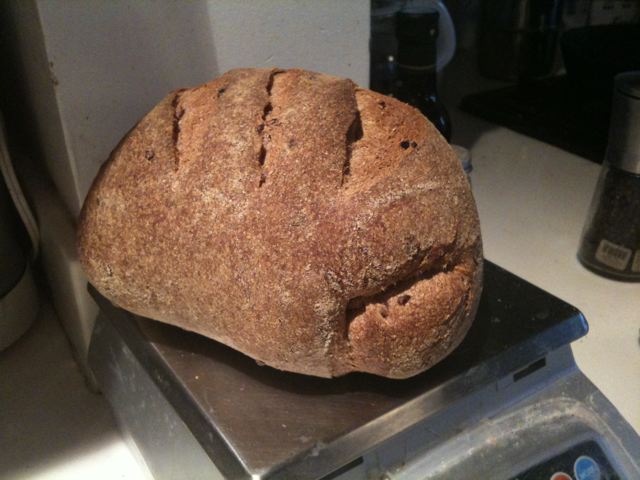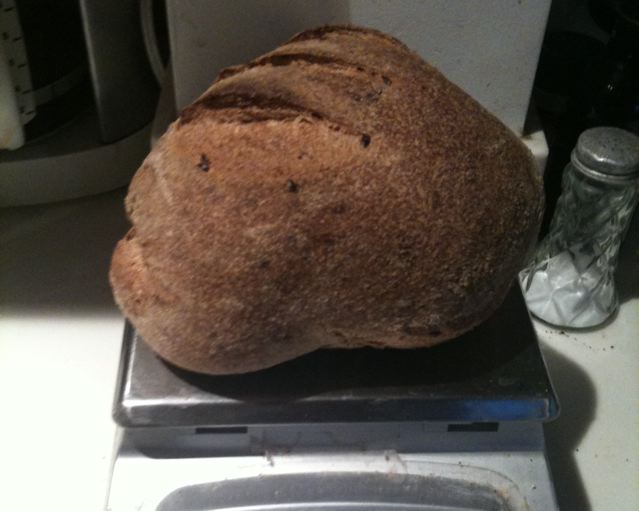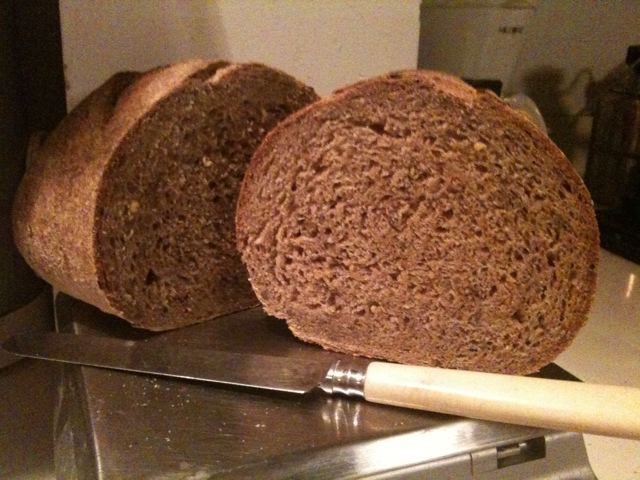Hello all -
just finished a rehab of my starter from a dormant period of 4 months
so this is my second loaf, its been a struggle getting back into the rhythm -
the real issue here is that i seem to always be guessing at baking time. the loaves come out chewy (which i have grown fond of) and even after a long cooling period when i finally them open they still seem to be somewhat moist and tender. even when i used an instant read thermometer i had the same problem.
The Loaves.
83% Hydration Loaf
Baking Time break Down
Preheat oven w/ stone @ 500 dF for 30-40 minutes (w/oven thermometer)
Bake at 425 for first 10 minutes
drop to 400 and bake for another ~30 minutes give or take depending on the loaf.
using an instant read thermometer always worried me because it just plunges through the crumb structure. what should i be doing differently?



Your baking temperatures seem low to me. Most lean type breads are baked at 450 F or higher by the successful bakers on this forum. You didn't specify the type of loaf in the photo, but it looks like a dark flour such as rye or spelt, so I can't tell if your crust is browned.
You might check your oven thermometer against your oven to see what the actual temp is. This can be difficult because some of these inexpensive oven thermometers aren't very accurate. I bought two different kinds that had good ratings on Amazon for less than $20 for the pair so I could test mine. They actually read very close.
Don't give up on your instant thermometer to test for doneness. At sea level you should get a read of at least 200 F in about 40 minutes with the size loaf you show. Deduct about 2 F for every 1000 ft above sea level where you live.
What is the bread and the flour you are using for the loaves you are concerned about? Some breads are natuarally more heavy and moist than others. 83% is a very high level of hydration for most loaves, which run 65% to 75%. Most sandwich type loaves are in the middle of that range.
Hope that helps. Michael
As Micheal H notes, it's hard to say without more info.
I've baked loaves at 400 before, but when I go that low I generally go for an hour. Typically at 425 I go 50 minutes.
You seem to have gone 400 for 40, which seems pretty short an amount of time.
Did it sound hollow when you rapped the bottom of the loaf?
http://www.akuindeed.com
yea it did sound hollow, mostly i go by feel, theres always a kind of uncanny lightness to a well cooked loaf but ive been out of practice for a while.
thanks for your input.
what do you recommend for a baking time?
its 100% whole wheat (high protein winter wheat)
i know its a high hydration, i have very good results with lightness/ovenspring of the 100% whole wheat loaves this way. its the loaves i learned to make when i was a baker;s apprentice but he of course has a lovely woodburning brick oven.
i'll try a higher temp next round. thanks for the help
If you stick with 40 min, definitely go higher in temp (425 - 450) If you go up to 50 min, try 425, or at 400 go a full hour.
That's what I'd try!
www.akuindeed.com
Because, except for determining when to lower the oven temperature and when to rotate my loaves, I never use the clock to determine when I execute the next step in my bread baking exercises, I can't say much about the amount of time you're applying to the baking phase. For the bread you describe I would start with a 500 degree oven, turn it down to 450 after five minutes and finish the loaf, turning 180 degrees after fifteen minutes, to an internal temperature of about 205 - 210 degrees.
Watching the clock will cause you more grief than perhaps anything else in bread making. A loaf that baked perfectly yesterday at 450 degrees for 25 minutes is unlikely to perform exactly the same today, unless you have a controlled environment with a commercial oven and precision controls.
using an instant read thermometer always worried me because it just plunges through the crumb structure.
Can you explain a bit more? What do you worry will happen? Is your worry along the lines of not getting an accurate reading of crumb temperature, or along the lines of damaging the crumb, or something else?
using an instant read thermometer
I (maybe it's just a personal problem:-) at least didn't find the critical information here! [u]What temperature?[/u] When using a thermometer to judge doneness, what temperature do you look for and/or what temperature did you measure?
(I hope you weren't judging doneness some other way, then also taking an internal crumb temperature reading just for grins.)
you're absolutely right! i didnt provide that information. my mistake :)
as for the instant thermometer - i do worry about damaging the internal crumb structure, is that a valid worry or should i just be more concerned with doneness?
as for the temperature - when i used an instant read i read to 203 dF
i think it mostly has to do with the low temperatures with my very high hydration loaf - which really works for me in all other respects. i get very light whole wheat loaves most of the time (when they're fully baked!)
I initially tried both a cabled in-oven thermometer and the out-of-oven instant read thermometer. I started out quite dubious about the crumb, expecting to find long straight hollow spots the size of the thermometer probe in the crumb. But I never did!
(I eventually discarded the in-oven thermometer in favor of the instant read thermometer, which I personally found less of a hassle and more forgiving. In reality, it probably had something to do with the time I caught the probe cord on the oven door and pulled a lump of dough right off my baking stone onto my oven door:-)
I shouldn't have worried: even the occasions when I've guessed the time very badly and had to insert the instant read thermometer probe quite a few times, I've never found any crumb damage. I just insert the probe through one end or the other and push it in several inches so the tip of the probe is about in the middle of the loaf, switching ends each time so neither end crust looks too much like a pincushion. (I do take care to make a new hole each time though, as I'm afraid [perhaps needlessly:-] that trying to reuse the old hole would give me an inaccurate temperature reading.) If I was more concerned about appearance I could always turn the loaf over and insert the thermometer probe through the bottom crust (of course pushing it in only a short way so it doesn't contact the inside of the top crust on the other side).
203F sounds pretty low to me. Although much advice is to start with 205F, I've found for myself that with a completely lean dough I have to go all the way to 210F to get the results I like best. (I've also found that the the thermometer goes up rather slowly for the last few degrees, so if I'm too impatient and take a reading as soon as the thermometer slows down [rather than not changing at all for several seconds], I get a reading that's about 3F lower than I would otherwise.)
Depending on loaf shape, oven temperature, and who knows what else, getting to 210F often takes me around 50 minutes.
I'd guess that while "mushy" is a function of baking time, "chewy" comes from using too strong flour. Maybe it makes sense to try something like KAF AP (still higher gluten than most other APs) or even GM AP.